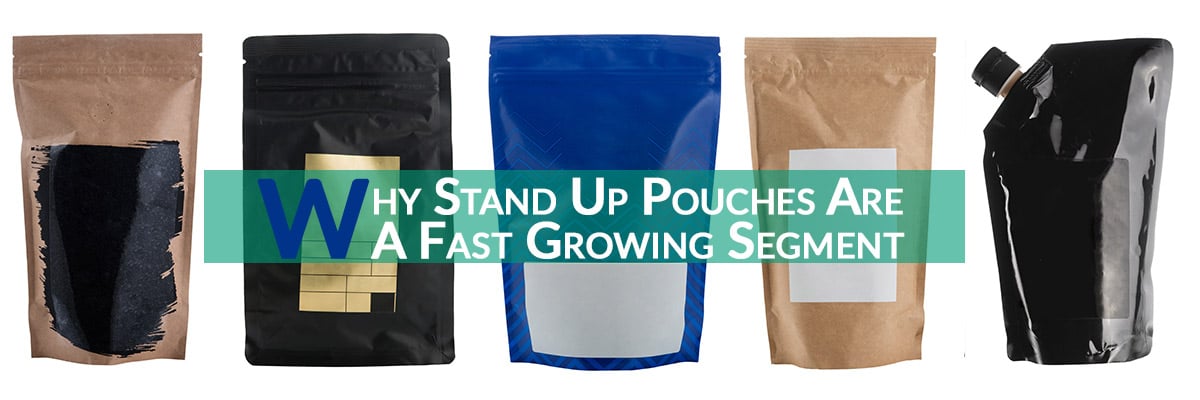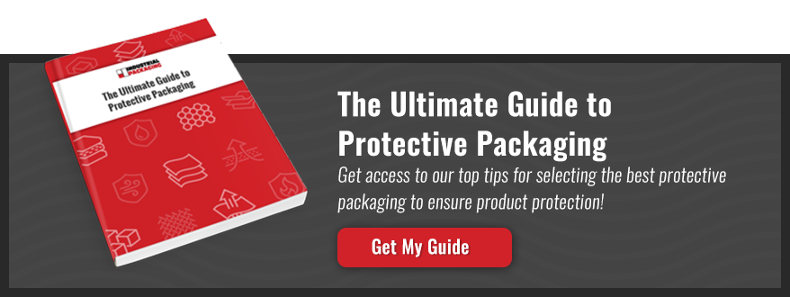Why Stand Up Pouches Are a Fast-Growing Segment
Equipment | Packaging Materials | The Business of Packaging | Plant Performance | Investment | Packaging Design | Food Packaging | Packaging Psychology
Packaging trends pop up pretty quickly, and even when you have your finger on the pulse of the industry, there are always innovative new ways to present your items that you may not have considered.
One of the most convenient, flexible, and trending new options are stand up pouches. They’ve been around for decades, but with the public’s growing interest in efficiency and waste reduction, they’re rapidly growing in popularity.
Basically, stand up pouches are soft sided containers that stand up on their own, unsupported. They usually have a resealable zipper, track, and/or spout, and can carry solid, liquid, or powdered items.
Are you utilizing flexible protective packaging or thinking about using it for your product lines??
Download our free eGuide to Protective Packaging!
If you’re trying to envision what these pouches look like, think of that elementary school lunchbox staple: Capri Sun single-serve drinks. Many baby food or granola containers also come in stand up pouches.
Scan the shelves of any retailer in 2019, and you’ll start noticing stand up pouches all over the place.
Flexible Pouches: One of the Fastest Growing Flexible Packaging Segments
Because they’re functional, flexible, and have a wealth of potential uses, stand up pouches (also known as flexible pouches) are more popular than ever — and an important addition to the options available in manufacturing.
More and more products are being offered in these pouches, from coffee beans to soap refills to potato chips.
According to a study from the Freedonia Group, demand for stand up pouches in the U.S. will grow almost 6% year over year to $2.9 billion by 2022.
Because they’re light and take up less shelf space, stand up pouches often make product handling and storage easier — so they should be a serious packaging consideration for many manufacturers.
The Benefits of Stand Up And Gusseted Pouches for Brands, Manufacturers, and Consumers
Stand up pouches and gusseted pouches come with many potential benefits, depending on your product needs or contents.
These include:
- Resealability
- Stand up pouches are often resealable, a major plus for consumers. With reclosable sliding zippers, for example, perishable snacks like vegetables stay fresh for longer. Plus, they make opening and closing the products much easier for people who may have disabilities or face challenges with dexterity.
- Clear windows
- Transparency is an option with pouches. These windows allow consumers to view the container’s contents and frequently increasing likelihood of purchase. As a recent Forbes article noted, “Going beyond just the listed ingredients on the label, consumers also want to see the physical product before purchase.”
- Recyclability
- These pouches are often recyclable, or can be made with recyclable or sustainable materials — a key ingredient for today’s market expectations. There are limitations once you get into multi-layer pouches that include foil and other barrier layers.
- Fewer materials
- Stand up pouches require less material to produce than many competing options, reducing waste and manufacturing costs, and lowering the carbon footprint. Since they’re lighter, it also reduces transportation costs. Consumers are also seeking more sustainable options, so these pouches offer retail appeal.
- Stand up pouches require less material to produce than many competing options, reducing waste and manufacturing costs, and lowering the carbon footprint. Since they’re lighter, it also reduces transportation costs. Consumers are also seeking more sustainable options, so these pouches offer retail appeal.
- Spouts
- Added spouts on top of these pouches allow products like sauces and other liquids to be easily poured without any added mess.
- Durability/Stiffness
- Even though stand up pouches are made from flexible materials, they’re hardy, and designed to remain standing — even if the pouch is only partially full. That’s they they’re perfect for resealable products or items that may be used intermittently.
- Even though stand up pouches are made from flexible materials, they’re hardy, and designed to remain standing — even if the pouch is only partially full. That’s they they’re perfect for resealable products or items that may be used intermittently.
- Handles
- Handles are an additional choice for stand up pouches. Adding these allows consumers to easily carry the product without the need for an additional bag.
In addition, the stand up pouches trend is in keeping with consumers shifting eating habits. People are moving away from three main meals and moving towards eating snacks and smaller items throughout the day.
According to a 2018 study by Technomic, consumers are more likely now (than in 2016) to replace one or two meals per day with snacks, instead. 80% of consumers say they snack at least once a day.
Stand up pouches support that trend, as they’re often resealable and/or can contain small portions, perfect for single-size servings.
Manufacturing Challenges That Come with Stand Up Pouches
While stand up pouches are the perfect fit for many items — from cleaning products to food items — they’re certainly not for everyone.
They do present specific challenges when it comes to manufacturing and packaging, and aren’t an ideal choice in all scenarios.
Some of the challenges that come with stand up pouches include:
- Machinery changes. The filling machinery required for stand up pouches can be expensive to implement. It’s a different system that what’s traditionally in place for packaging, and not all organizations have the capital to invest in something new. Check out this video of how the machinery works:
- Inefficiency. While the pouches themselves may be an efficient means of storage and containment, the filling process itself isn’t always. It depends on the product in question. With breakfast cereals, for instance, the filling process or line speed of stand up pouch machinery would have to equate with the speed of current equipment — and that just isn’t the case yet.
- Unsuitability. Not all products are good contenders for stand up pouches. Take ice cream, for example. Frozen treat containers need rigid sides; scooping the contents requires resistance.
Consider Whether Stand Up Pouches Could Work for You
While stand up pouches aren’t a “one size fits all” solution for packaging, they are a flexible, efficient technology with a wide variety of uses — and a great addition to the growing selection of more sustainable, customizable options for manufacturers.
If your company makes a product that sounds like a fit for this type of packaging, it’s definitely worth exploring what’s available.
And if you’re thinking about utilizing flexible packaging that protects your products, be sure to download our free eGuide To Protective Packaging!
About David Roberge
I am grateful to be part of the outstanding Industrial Packaging team. I am able to hang out with some of the most knowledgeable folks in the packaging industry. I feel even luckier that I am able to share that knowledge with you. I love learning, hiking, and growing people and teams both personally and professionally, and helping companies grow better.



